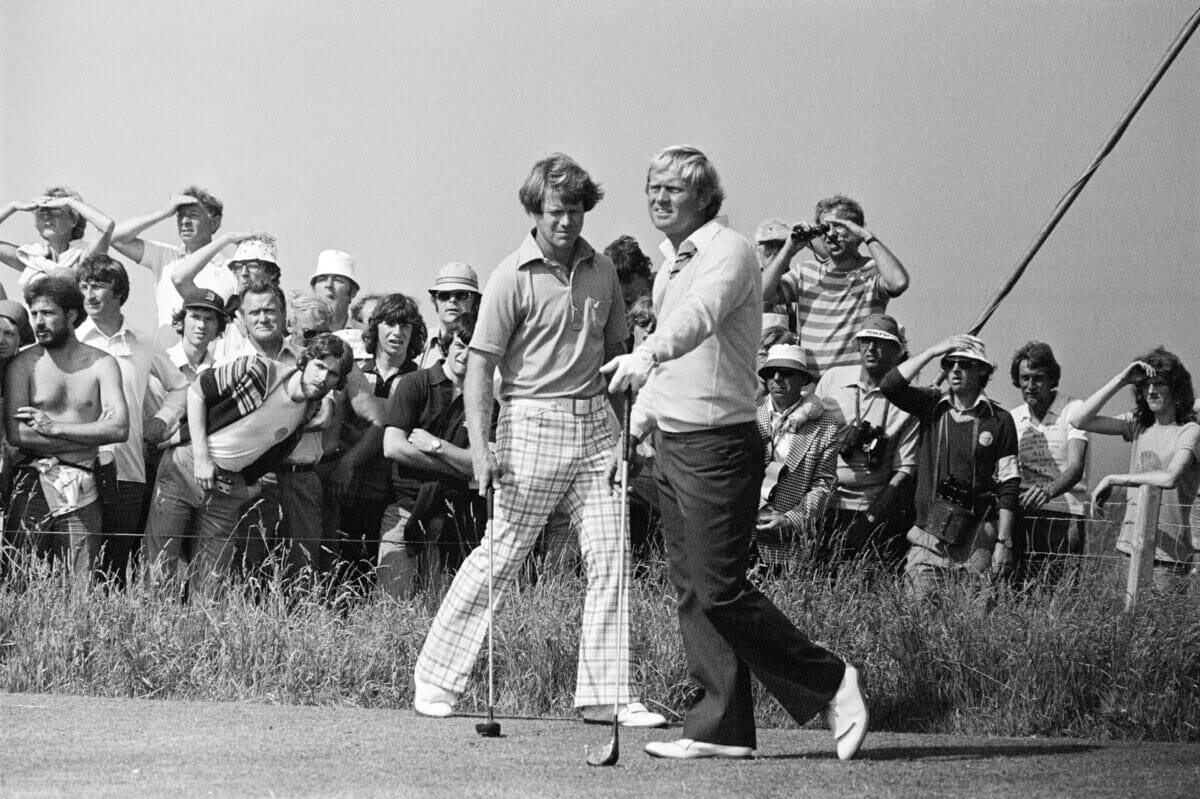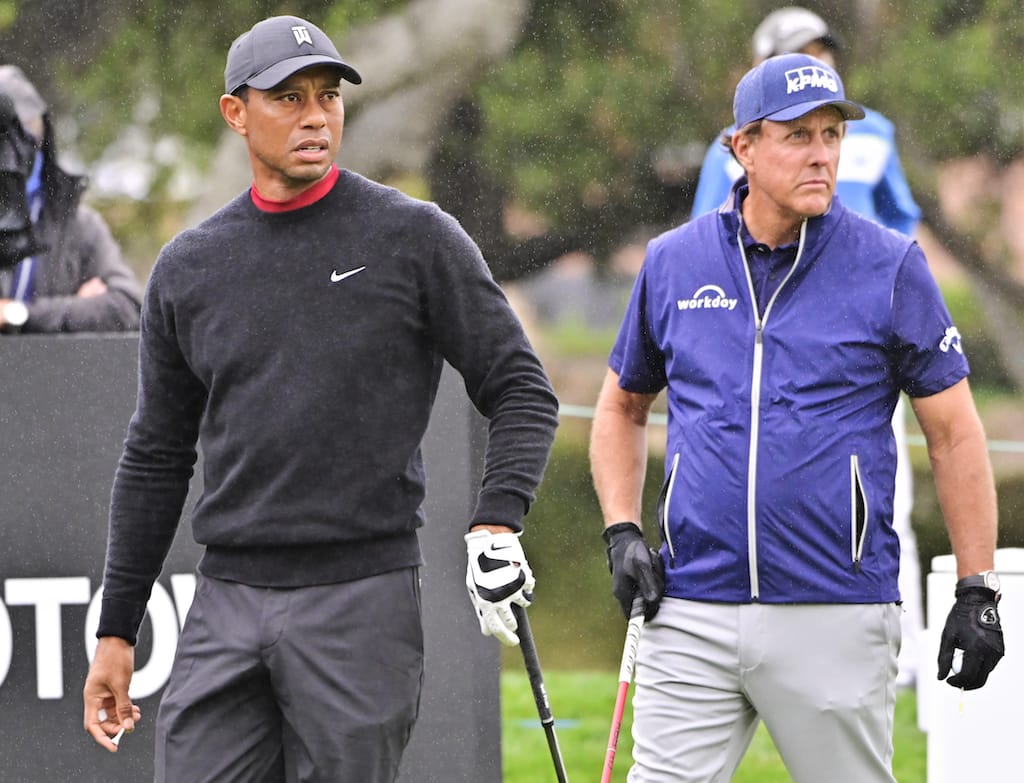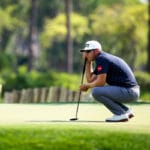Tiger Woods v Phil Mickelson –the number one rivalry in the history of golf? Not in my humble opinion.
In fact, when Tiger and Phil are presented as serious contenders to match historic rivalries such as Jack Nicklaus v Tom Watson, or Nicklaus v Arnold Palmer, or Nicklaus v Lee Trevino, Nicklaus v Gary Player, I’m not buying it.
The mind goes immediately to that great scene in the film “Crocodile Dundee” when Aussie bushman Mick Dundee is confronted by a would-be mugger in a New York subway.
Wannabe mugger brandishes a switchblade at Dundee, threatening to use it if the Aussie does not hand over his wallet. Unabashed, “Crocodile” looks with detached interest at the weapon being wielded by the mugger and then laughs.
Reaching behind his back, Dundee says, “That’s not a knife.” He then pulls out a huge blade of his own and says “THAT’S a knife” as he slices a chunk out of yer man’s jacket. Shock and awe immediately achieved. Exit failed mugger at warp speed.
Much the same applies to Tiger v Phil in terms of the best duels in professional golf. Call their share of the spotlight over the last 25 years a rivalry? Nah. THIS is a rivalry.
It’s the Duel in the Sun between Watson and Nicklaus at Turnberry in 1977, the result in the balance as play ebbs and flows right up to the 72nd hole. Watson shoots 65, Jack shoots 66 and the Claret Jug goes to Tom after an epic battle.
It’s the 1982 US Open at Pebble Beach when Jack is finished his fourth round and the galleries are waiting for play to finish hail another Nicklaus championship.
Out on the course, Watson produces a magic chip from greenside rough to hole out for birdie on the 17th, setting himself up for a superb snatch and grab at The Bear’s expense.
It’s The King, Arnold Palmer, rocking up to the US Open at Oakmont in 1962 as reigning Masters champion and a rampant favourite for victory.
Instead, a chubby, blond, Germanic-looking, dour 22-year old from Ohio in Middle America playing his first major as a professional defied the odds and had the effrontery to beat Palmer in an 18-hole playoff. He shot one-under par 71 to Arnold’s 74
The shock was all the greater because it happened at a time when pros had to serve their apprenticeship and learn how to compete on Tour.
Nobody, least of all Arnie’s Army of devoted fans, thought it likely that rookie pro Jack could take on their hero and beat him in the toughest major of them all.
Further back, Sam Snead and Ben Hogan did not like each other very much, and competed fiercely to outdo each other.
Snead’s famous quote sums it up: “The things I fear most in golf are lightning, Ben Hogan, and downhill putts!”
And there’s the rub.
For me, it’s all about one guy who can and does beat the other guy when it counts most and over a long period of time. Nicklaus was the new gunslinger in town who shot down Arnie.
In turn, along came Watson’s emergence as a huge threat to Jack, capable of beating him as often as he could lose to The Bear.
Player scrapped way above his weight – literally and figuratively – against Nicklaus and Palmer and later Trevino. Any of those players could defeat each other on any given day, especially when the stakes were highest and major tournaments were in the balance.
Tiger Woods and Phil Mickelson’s era compared with those other players mentioned above does not match the criteria which I believe strictly define the best golfing rivalries.
For a start, Woods, five years younger than his fellow Southern California native, had won eight major titles before Mickelson won his first, The Masters in April 2004 at age 33.
Also relevant is that when Tiger played his best, he won, and kept on winning for years while Lefty had a relatively late surge based on re-dedicating himself to fitness, course and self-management and technical improvements.
Huge credit is due to Phil for his achievements, but it must be said that after winning his 14th major in a playoff against Rocco Mediate in the 2008 US Open, Woods endured a horrendous period in his life on and off-course. Tiger had no right to play at Torrey Pines that week, such was the extent of the pain he suffered from a cruciate knee injury plus two stress fractures in his tibia.
The pain factor was huge but shot by shot, the amazing mental strength of the man forced his aching body to comply with the order to keep going, no matter how much suffering was involved.
Had he not been a serial womaniser and been caught out in 2009, and had he not messed around with bouts of training with US Navy Seals which aggravated knee and back injuries that affected Woods for the next decade, you would have to ask: Could Phil Mickelson or anyone else prevented Tiger from beating Nicklaus’ major haul of 18 professional titles?
I don’t think so.
And that brings us to a new book called: “Tiger and Phil” with the sub-head: “Golf’s most fascinating rivalry” by respected American golf writer Bob Harig.
The author has done a commendably thorough and well-written job in chronicling the life and times of two great players.
His research is painstaking and thorough. He has a plethora of quotes from Woods and Mickelson, has interviewed fellow players, and coaches – both men were under the guidance of Butch Harmon at critical junctures in their careers – and caddies.
He goes into detail about their different upbringings, their shared obsession with golf, their hunger to win and win big every time they tee it up.
The narrative is spiced up with juicy anecdotes, such as the day Tiger’s third successive US Amateur title was achieved on the day – August 15, 1996 – that Phil won the World Series of Golf. By doing so, Mickelson broke into the World rankings top ten for the first time and captured his ninth Tour title.
Good story, right? Not in the eyes of the US and international media because Tiger was turning pro with $40 million dollars of endorsement contracts, so the World Series of Golf victory was virtually ignored.
Two years later, they first played a practice round at the Nissan Open, played at Valencia Country Club.
It ended with Phil taking $500 dollars from Woods in a practice round at the CA Open in 1998.
Phil always likes to wind up his “victims” so he photo-copied the five 100 dollar bills, and left them in Woods’ locker with a note saying “Just wanted you to know Benji (Benjamin Franklin’s image is on 100 dollar bills) and his friends are very happy in their new home.”
The joke was lost on Tiger. He didn’t enjoy losing money to Phil one bit.
The next practice round they played together was at the 2018 Masters – twenty years later.
And who can forget the 2004 Ryder Cup misfit partnership when paired in fourballs and foursomes by eternal optimist USA captain Hal Sutton?
The body language of the two players spoke volumes for their discomfort in playing together.
Before Phil won his first major, the 2004 Masters, fitness freak Tiger questioned Mickelson’s commitment and physical prowess to the extent he once called Phil “a fat F…”.
Ouch!
Steve Williams, Woods’ caddie for 12 years during which Tiger won 13 majors, also got caught out with a less than flattering assessment of Mickelson in 2008.
Williams attended a function in his native New Zealand which he thought was private, so he unburdened himself of his frank opinion of Phil.
He said he felt Mickelson was arrogant and “I just don’t like the p…k”
Unfortunately somebody leaked the comments. Williams couldn’t and didn’t deny what he said and got a public rebuke from Tiger. Williams said he had been making a joke but didn’t take it back.
The book is timely for a number of reasons, not least that Mickelson has put himself firmly in a spotlight of controversy recently. Once the darling of the galleries and “The People’s Champion”, Phil has blotted his copybook with the PGA Tour and fellow professionals over the cash-laden potential of the Saudi-backed Golf League.
Social media and mainstream media erupted with many adverse comments about a multi-millionaire calling the PGA Tour “greedy.” The fallout included Phil losing huge sums of money as sponsors reversed out the door in fear of being tainted by perceived negativity attaching to the new “Phil The Pariah” status.
It’s overblown, of course, but such is the cancel culture hysteria of the modern era. No doubt plenty of Tour pros were sounded out about the idea and were tempted by the prospect of playing exactly where they wanted and when they wanted for huge money, but got scared by the stern defence mounted by the PGA Tour of its own product.
Fair enough. There is plenty more to come on this topic, although it fades into nothingness compared to the horrors inflicted on the Ukrainian people and the knock-on effect for the rest of Europe and the world.
However, back to Harig’s book.
His work shines a spotlight on two complex but fascinating characters who contributed greatly to the rise in popularity of golf since the mid-Nineties.
If you want to know the influences that shaped Woods (45) and Mickelson (51) from the beginning to their current elder statesmen status on the Tour, it’s all here.
And hey! Read this and be reminded once again of the astonishing level of success they achieved in golf, step by step.
Tiger’s 15 majors and 82 PGA Tour wins is amazing. Phil has 45 wins and six majors.
Harig points out that of the 12 major championships played from 2004 to 2006 inclusive, Woods and Mickelson won seven between them.
And how about their most recent achievements?
Tiger’s 15th major at the 2019 Masters was truly awesome. Phil’s enthronement as US PGA Champion last year at the age of 50, making him the oldest major winner in history was in itself worthy of a Hollywood film script.
But…. there’s a ‘but’ in my mind.
They didn’t go head-to-head often enough at the closing stages of the biggest tournaments. Phil wasn’t remotely as big a threat to Tiger at the latter’s peak as Watson, Trevino, and Player were to Nicklaus, who in turn eclipsed Palmer.
True, they didn’t like each other much, but as hard as Phil tried to compete with the dominant player of the Nineties and first decade of the 2000s, he never overtook Woods as world number one.
Harig’s book is a worthy read for any golf fan. I enjoyed it particularly for the detailed narrative of their rise from childhood prodigies to Tour Superstars and the insights into their personalities and characters.
The only slight drawback – call me a pernickety curmudgeon – is in the title: Golf’s ‘most’ fascinating rivalry.
Their rivalry is up there, and certainly their respective on and off-course adventures and misadventures qualify as fascinating.
But THE most fascinating in golf history? Close, but no cigar.


























Leave a comment